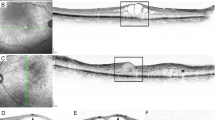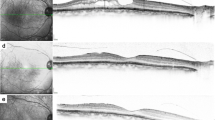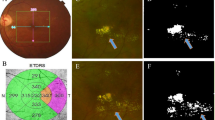Abstract
Purpose
To determine the relationship between cystoid macular edema (CME) and disease severity and progression in non-paraneoplastic autoimmune retinopathy (npAIR).
Methods
A retrospective study was conducted on patients seen between 2008 and 2016 with npAIR as defined by electroretinogram (ERG) dysfunction, visual field changes, presence of antiretinal antibodies, a negative malignancy workup, and no other apparent cause for visual dysfunction. Optical coherence tomography (OCT) scans were reviewed for each patient. A minimum follow-up of 1 year was necessary for study inclusion. The presence or absence of CME and the length of the preserved EZ on the centermost line scan of the SD-OCT images was recorded at each visit. The main outcome measure assessed was the rate of EZ loss (EZ final − EZ initial / days follow-up) over time, a marker for disease progression.
Results
Thirty-two eyes (16 patients) were included with an average follow-up of 42 months. Twenty-one eyes (66%) had CME on initial presentation and final follow-up (group 1), eight eyes (25%) did not have CME on presentation or final follow-up (group 2), and three eyes (9%) did not have CME on presentation but developed CME during follow-up (group 3). Group 1 eyes had a lower maximal a-wave amplitude (59.0 vs. 220.9 mV, p = 0.012) and lower maximal b-wave amplitude (88.1 vs 256.9 mV, p = 0.017) on baseline ERG compared to Group 2 eyes. The rate of EZ loss over time was significantly greater for group 1 with CME compared to group 2 without CME both at 12 months (− 1.26 μm/day vs. − 0.26 μm/day, p = 0.022) and at final follow-up (− 1.03 μm/day vs. − 0.08 μm/day, p = 0.012).
Conclusions
CME was associated with decreased ERG amplitudes and greater velocity of EZ loss, suggesting that CME is a useful biomarker of more severe and more progressive disease in npAIR.




Similar content being viewed by others
References
Chan JW (2003) Paraneoplastic retinopathies and optic neuropathies. Surv Ophthalmol 48:12–38
Heckenlively JR, Ferreyra HA (2008) Autoimmune retinopathy: a review and summary. Semin Immunopathol 30:127–134
Grange L, Dalal M, Nussenblatt RB et al (2014) Autoimmune retinopathy. Am J Ophthalmol 157:266–272.e1
Fox AR, Gordon LK, Heckenlively JR et al (2016) Consensus on the diagnosis and management of autoimmune retinopathy using a modified Delphi approach. Am J Ophthalmol 168:183–190
Pepple KL, Cusick M, Jaffe GJ, Mruthyunjaya P (2013) SD-OCT and autofluorescence characteristics of autoimmune retinopathy. Br J Ophthalmol 97:139–144
Heckenlively JR, Solish AM, Chant SM, Meyers-Elliott RH (1985) Autoimmunity in hereditary retinal degenerations. II. Clinical studies: antiretinal antibodies and fluorescein angiogram findings. Br J Ophthalmol 69:758–764
Abazari A, Allam SS, Adamus G, Ghazi NG (2012) Optical coherence tomography findings in autoimmune retinopathy. Am J Ophthalmol 153:750–756.e1
Ferreyra HA, Jayasundera T, Khan NW et al (2009) Management of autoimmune retinopathies with immunosuppression. Arch Ophthalmol 127:390
Larson TA, Gottlieb CC, Zein WM et al (2010) Autoimmune retinopathy: prognosis and treatment. ARVO E-Abstract 6375
Adamus G, Ren G, Weleber RG (2004) Autoantibodies against retinal proteins in paraneoplastic and autoimmune retinopathy. BMC Ophthalmol 4:5
Lima LH, Greenberg JP, Greenstein VC et al (2012) Hyperautofluorescent ring in autoimmune retinopathy. Retina 32:1385–1394
Sepah YJ, Sadiq MA, Hassan M et al (2015) Assessment of retinal structural and functional characteristics in eyes with autoimmune retinopathy. Curr Mol Med 15:578–586
Heckenlively JR, Jordan BL, Aptsiauri N (1999) Association of antiretinal antibodies and cystoid macular edema in patients with retinitis pigmentosa. Am J Ophthalmol 127:565–573
Qian CX, Wang A, DeMill DL et al (2017) Prevalence of anti-retinal antibodies in acute zonal occult outer retinopathy (AZOOR): a comprehensive review of 25 cases. Am J Ophthalmol 176:210–218
Author information
Authors and Affiliations
Corresponding author
Ethics declarations
Financial support/disclosures
Glenn J. Jaffe is a consultant for Heidelberg Engineering.
The authors have no other financial disclosures to report.
Conflict of interest
All authors certify that they have no affiliations with or involvement in any organization or entity with any financial interest (such as honoraria; educational grants; participation in speakers’ bureaus; membership, employment, consultancies, stock ownership, or other equity interests; and expert testimony or patent-licensing arrangements), or non-financial interest (such as personal or professional relationships, affiliations, knowledge, or beliefs) in the subject matter or materials discussed in this manuscript.
Ethical approval
All procedures performed in studies involving human participants were in accordance with the ethical standards of the institutional and/or national research committee and with the 1964 Helsinki declaration and its later amendments or comparable ethical standards.
For this type of retrospective study, formal consent is not required.
Additional information
Meeting presentation
This was presented as a paper at the Retina Society Meeting, 2017 in Boston.
Rights and permissions
About this article
Cite this article
Finn, A.P., Thomas, A.S., Stinnett, S.S. et al. The role of cystoid macular edema as a marker in the progression of non-paraneoplastic autoimmune retinopathy. Graefes Arch Clin Exp Ophthalmol 256, 1867–1873 (2018). https://doi.org/10.1007/s00417-018-4084-8
Received:
Revised:
Accepted:
Published:
Issue Date:
DOI: https://doi.org/10.1007/s00417-018-4084-8




